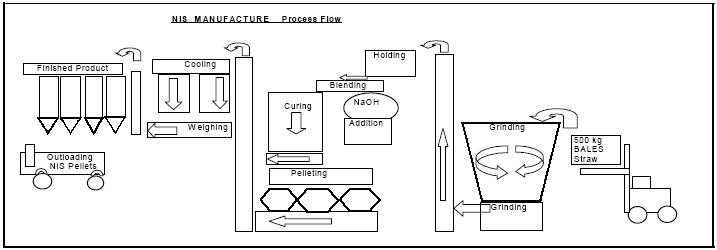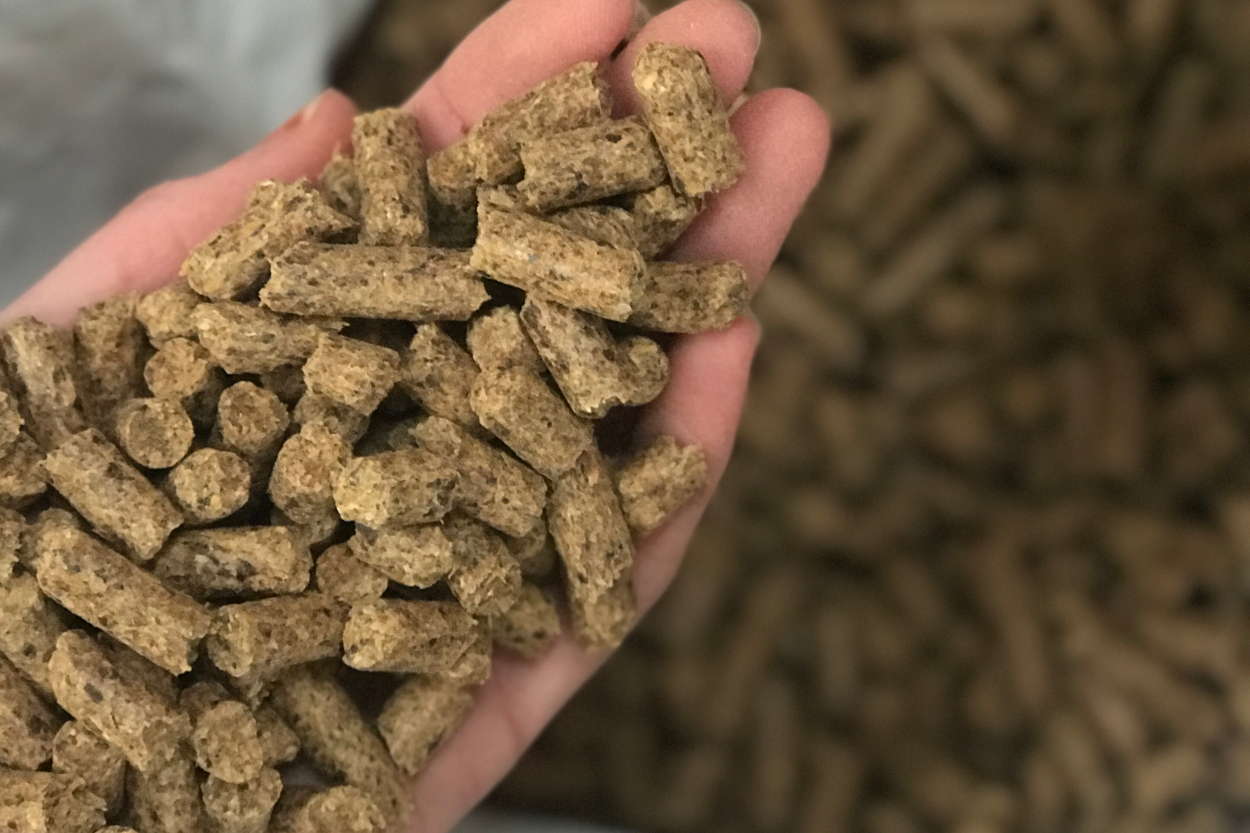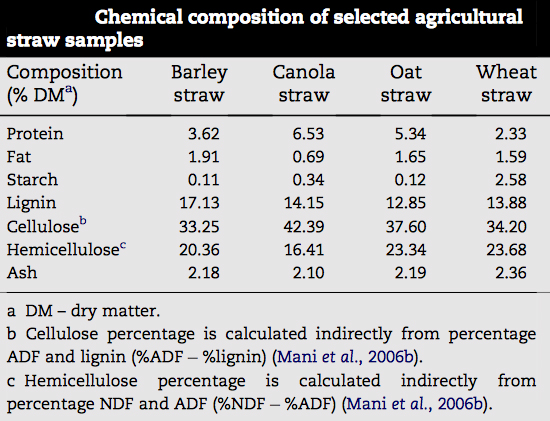Article Index
Nutritionally Improved Straw (NIS) Pellets
-
NIS pellets are very high in fibre (about 33%).
-
NIS pellets make a nutrient contribution to the ration, and modifies the way the rumen functions and affects how the rumen handles other feeds in the diet including fresh grass.
-
NIS is a complementary feed, and the fibre in NIS is "functional" fibre.
-
The Straw Pellets are produced from a unique patented process where cereal straw is treated with low levels of sodium hydroxide (alkali treatment) and extruded to accelerate the chemical breakdown of the fibrous fraction. This process increases the ‘D’ value of the straw from approximately 38% to 62% producing an economical source of energy ideal for all ruminant, horse and rabbit foods.
Process flow diagram (from Sundown products): 

Nutritionally Improved Straw Pellets analysis (%) on a dry matter basis:
Protein |
Oil |
Crude Fibre |
Digestible fibre |
Ash |
4 |
1.5 |
33 |
25 |
10 |
Dry Matter (%) |
Metabolisable energy (ME)(mega joules/kg dry matter) |
Neutral Detergent Fibre (NDF) (%) |
Moisture (%) |
89 |
8 |
78 |
11 |
Straw Pellets are:
-
Highly economic energy ingredient.
-
Suitable for all ruminant, horse and rabbit foods (at different inclusion rates)
-
High in digestible fibre
-
Manufactured from Patented process
 Usage
Usage
-
In dairy cows, Straw Pellets can be used in compound feeds up to 25% of the ration.
-
In beef cows, Straw Pellets can be used in compound feeds up to 30% of the ration.
Benefits
-
Nutritionally Improved Straw Pellets is a forage extender and a digestive aid.
-
It's also an economical source of energy from digestible fibre and a rumen conditioner for cows. It also contributes sodium carbonate and sodium bicarbonate and can improve the utilisation of all the raw materials in the diet.
Origins
-
The pellets are manufactured in Britain from British straw and therefore has full traceability and it FEMAS certified.
Feeding levels
-
Because NIS is a source of functional fibre from plant stems, overfeeding is unlikely to be a problem. With any forage, animals tend to limit their intakes.
Storage
-
Kept dry and covered, NIS will not go off and can keep for many months.
-
Any product left over from winter feeding can be used to correct imbalances in spring grass. (All our rations are regularly tested by a DEFRA approved laboratory.)

Related articles
NIS IS BACK (British Dairying, April 2006)
“Cows must be hungry to eat straw”. This was the comment about 10 years ago from a dairy farmer where I had advised the inclusion of 0.5kg/day of chopped straw to the diet. He took some convincing even though I explained how it would improve rumen function. When he finally submitted to my request, he became a true convert upon seeing the results.
Chopped straw is now accepted as a sensible addition to many dairy rations. However, it is not without it’s downsides. It is not cheap (about £66/tonne) and you need a large storage area. Accurate inclusion can be difficult.
An old friend has returned that is doing a great job, and in my opinion is better than chopped straw. I am talking about Nutritionally Improved Straw (NIS) in pellet form. NIS has been doing a superb job on a couple of client’s farms. I have seen an improvement in butterfat, more milk, less acidosis and less displaced abomasums – all since including NIS pellets.
Midlands client -Change from 1kg straw to 2kgs NIS
Milk yield |
31 litres - No change |
Butterfat % |
3.98 to 4.28 |
So why not feed chopped straw instead? Because straw is as different to NIS as wheat is to bread! NIS starts life as plain straw, but it is chopped and treated with sodium hydroxide. This breaks down the indigestible outer layer, allowing access for the rumen micro-organisms. It is then pelleted, and when there is contact with the air during cooling, the sodium hydroxide converts to bicarbonate of soda. This is a valuable rumen buffer.
We now have a pellet that has higher digestible fibre and higher energy than straw, and comes with it’s own rumen buffer.
You may wonder why NIS fell out of favour if it is doing such a good job now. I think computerised ration programmes were a major factor. These programmes evaluate rations and look at such things as energy, protein, starch, sugar and fibre. They do not show digestible fibre. NIS will never be used on a pure analysis basis. With energy of 8.5 MJ/kg DM and a protein of 5%, it does not compete on paper with many forages, let alone straights.
But it is what it does, rather than what it is at face value that is important. It makes the rumen work better.
I believe NIS is more relevant now than in the past, as we feed more products that NIS helps balance. We feed more starch such as cereals, maize silage and whole crop. Higher milk yields also require higher concentrates, thereby skewing the forage to concentrate ratio. As most milk buyers are paying more for butterfat, we add expensive fat supplements to the diet. It can be a short-term answer, but I prefer to create a healthy rumen and then the butterfat comes naturally. Cows are then healthier, get back in calf quickly and stay on the farm longer.
One of my clients has just replaced Lucerne bales with NIS pellets on a 2kg/cow/day basis. We will see what happens especially as we are saving about £60/tonne!
With spring grass on the horizon, what could be a better balancer than NIS? High digestible fibre, low protein and sodium bicarbonate included.
There will be detractors to NIS – especially those that see everything through a computer screen and do not understand how rumens work. Some will compare it to Beet Pulp, Citrus Pulp, and Soya Hulls etc. These are concentrates. NIS is a forage, not a concentrate. It is time we started feeding cows as the ruminants they are.


